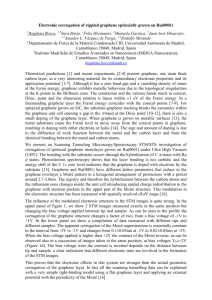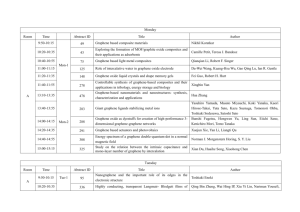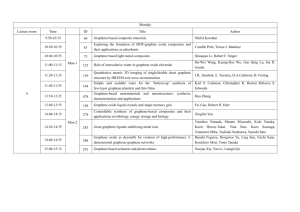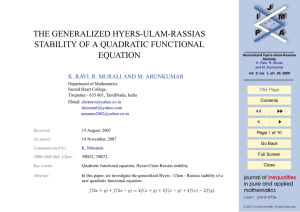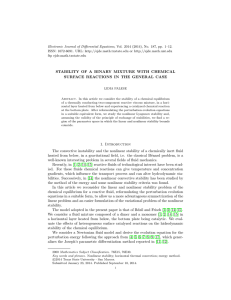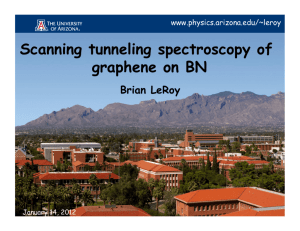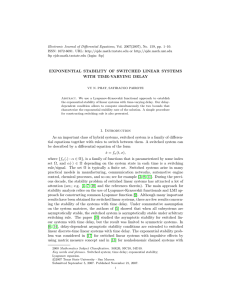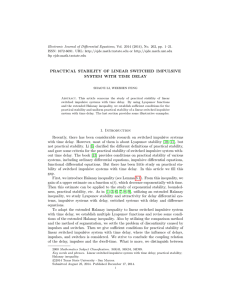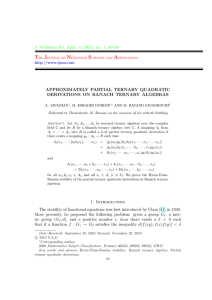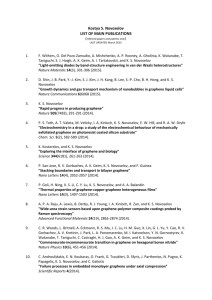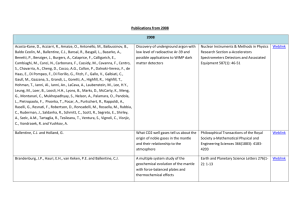Bollettino Settimanale - Dipartimento di Fisica
advertisement
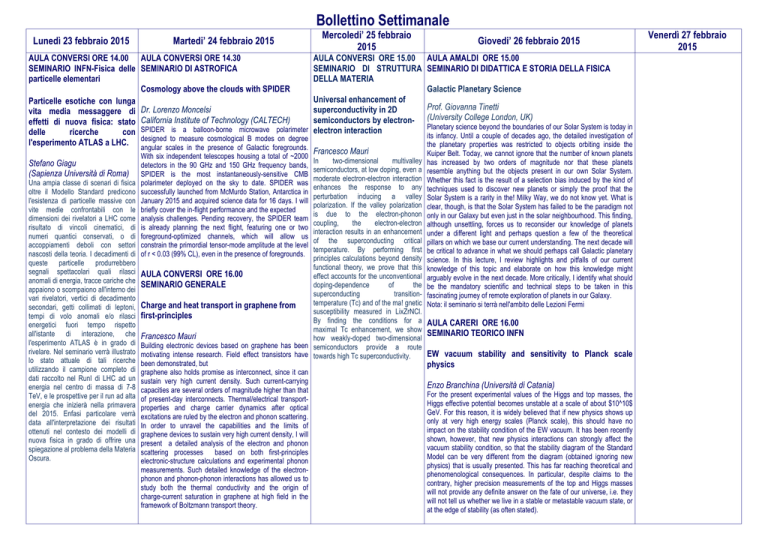
Bollettino Settimanale Lunedì 23 febbraio 2015 Martedi’ 24 febbraio 2015 AULA CONVERSI ORE 14.00 AULA CONVERSI ORE 14.30 SEMINARIO INFN-Fisica delle SEMINARIO DI ASTROFICA particelle elementari Cosmology above the clouds with SPIDER Particelle esotiche con lunga vita media messaggere di Dr. Lorenzo Moncelsi effetti di nuova fisica: stato California Institute of Technology (CALTECH) delle ricerche con SPIDER is a balloon-borne microwave polarimeter l'esperimento ATLAS a LHC. designed to measure cosmological B modes on degree Stefano Giagu (Sapienza Università di Roma) Una ampia classe di scenari di fisica oltre il Modello Standard predicono l'esistenza di particelle massive con vite medie confrontabili con le dimensioni dei rivelatori a LHC come risultato di vincoli cinematici, di numeri quantici conservati, o di accoppiamenti deboli con settori nascosti della teoria. I decadimenti di queste particelle produrrebbero segnali spettacolari quali rilasci anomali di energia, tracce cariche che appaiono o scompaiono all'interno dei vari rivelatori, vertici di decadimento secondari, getti collimati di leptoni, tempi di volo anomali e/o rilasci energetici fuori tempo rispetto all'istante di interazione, che l'esperimento ATLAS è in grado di rivelare. Nel seminario verrà illustrato lo stato attuale di tali ricerche utilizzando il campione completo di dati raccolto nel RunI di LHC ad un energia nel centro di massa di 7-8 TeV, e le prospettive per il run ad alta energia che inizierà nella primavera del 2015. Enfasi particolare verrà data all'interpretazione dei risultati ottenuti nel contesto dei modelli di nuova fisica in grado di offrire una spiegazione al problema della Materia Oscura. angular scales in the presence of Galactic foregrounds. With six independent telescopes housing a total of ~2000 detectors in the 90 GHz and 150 GHz frequency bands, SPIDER is the most instantaneously-sensitive CMB polarimeter deployed on the sky to date. SPIDER was successfully launched from McMurdo Station, Antarctica in January 2015 and acquired science data for 16 days. I will briefly cover the in-flight performance and the expected analysis challenges. Pending recovery, the SPIDER team is already planning the next flight, featuring one or two foreground-optimized channels, which will allow us constrain the primordial tensor-mode amplitude at the level of r < 0.03 (99% CL), even in the presence of foregrounds. Mercoledi’ 25 febbraio 2015 Giovedi’ 26 febbraio 2015 AULA CONVERSI ORE 15.00 AULA AMALDI ORE 15.00 SEMINARIO DI STRUTTURA SEMINARIO DI DIDATTICA E STORIA DELLA FISICA DELLA MATERIA Galactic Planetary Science Universal enhancement of Prof. Giovanna Tinetti superconductivity in 2D semiconductors by electron- (University College London, UK) Planetary science beyond the boundaries of our Solar System is today in electron interaction Francesco Mauri its infancy. Until a couple of decades ago, the detailed investigation of the planetary properties was restricted to objects orbiting inside the Kuiper Belt. Today, we cannot ignore that the number of known planets has increased by two orders of magnitude nor that these planets resemble anything but the objects present in our own Solar System. Whether this fact is the result of a selection bias induced by the kind of techniques used to discover new planets or simply the proof that the Solar System is a rarity in the! Milky Way, we do not know yet. What is clear, though, is that the Solar System has failed to be the paradigm not only in our Galaxy but even just in the solar neighbourhood. This finding, although unsettling, forces us to reconsider our knowledge of planets under a different light and perhaps question a few of the theoretical pillars on which we base our current understanding. The next decade will be critical to advance in what we should perhaps call Galactic planetary science. In this lecture, I review highlights and pitfalls of our current knowledge of this topic and elaborate on how this knowledge might arguably evolve in the next decade. More critically, I identify what should be the mandatory scientific and technical steps to be taken in this fascinating journey of remote exploration of planets in our Galaxy. Nota: il seminario si terrà nell'ambito delle Lezioni Fermi In two-dimensional multivalley semiconductors, at low doping, even a moderate electron-electron interaction enhances the response to any perturbation inducing a valley polarization. If the valley polarization is due to the electron-phonon coupling, the electron-electron interaction results in an enhancement of the superconducting critical temperature. By performing first principles calculations beyond density functional theory, we prove that this AULA CONVERSI ORE 16.00 effect accounts for the unconventional SEMINARIO GENERALE doping-dependence of the superconducting transitiontemperature (Tc) and of the ma! gnetic Charge and heat transport in graphene from susceptibility measured in LixZrNCl. first-principles By finding the conditions for a AULA CARERI ORE 16.00 maximal Tc enhancement, we show SEMINARIO TEORICO INFN Francesco Mauri how weakly-doped two-dimensional Building electronic devices based on graphene has been semiconductors provide a route EW vacuum stability and sensitivity to Planck scale motivating intense research. Field effect transistors have towards high Tc superconductivity. been demonstrated, but physics graphene also holds promise as interconnect, since it can sustain very high current density. Such current-carrying Enzo Branchina (Università di Catania) capacities are several orders of magnitude higher than that For the present experimental values of the Higgs and top masses, the of present-day interconnects. Thermal/electrical transportHiggs effective potential becomes unstable at a scale of about $10^10$ properties and charge carrier dynamics after optical GeV. For this reason, it is widely believed that if new physics shows up excitations are ruled by the electron and phonon scattering. only at very high energy scales (Planck scale), this should have no In order to unravel the capabilities and the limits of impact on the stability condition of the EW vacuum. It has been recently graphene devices to sustain very high current density, I will shown, however, that new physics interactions can strongly affect the present a detailed analysis of the electron and phonon vacuum stability condition, so that the stability diagram of the Standard scattering processes based on both first-principles Model can be very different from the diagram (obtained ignoring new electronic-structure calculations and experimental phonon physics) that is usually presented. This has far reaching theoretical and measurements. Such detailed knowledge of the electronphenomenological consequences. In particular, despite claims to the phonon and phonon-phonon interactions has allowed us to contrary, higher precision measurements of the top and Higgs masses study both the thermal conductivity and the origin of will not provide any definite answer on the fate of our universe, i.e. they charge-current saturation in graphene at high field in the will not tell us whether we live in a stable or metastable vacuum state, or framework of Boltzmann transport theory. at the edge of stability (as often stated). Venerdì 27 febbraio 2015 SALA DIREZIONE INFN ore 16.00 SEMINARIO STRUTTURA DELLA MATERIA A new paradigm for modeling: a virtual multifrequency spectrometer Prof. V. Barone (Scuola Normale Superiore, Pisa) The subtle interplay of several different effects still makes the interpretation and analysis of experimental spectra in terms of structural and dynamic characteristics a very challenging task. In this context theoretical studies can be very helpful and this is the reason behind the rapid evolution of computational spectroscopy from a highly specialized research field toward a versatile and widespread tool. In this presentation I will sketch the most significant developments performed also in the framework of the ERC Advanced Grant DREAMS. Integration into a general purpose computational chemistry package offers a fully automatic evaluation of one-photon electronic spectra, starting from several electronic models, ranging from fully QM descriptions to discrete/continuum QM/MM/PCM models. Additionally, introduction of effective DFT models allows reliable studies of compounds of biological or technological interest. Some specific examples will be sketched to illustrate our recent integrated approach.
